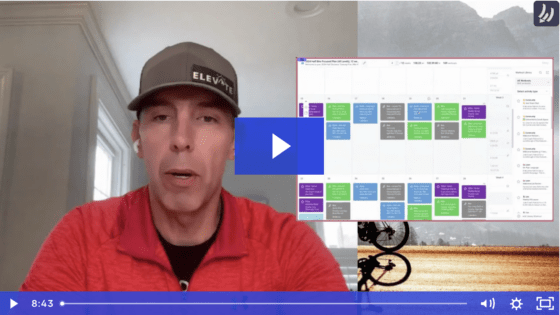In Part I we introduced you to the Four Keys of Triathlon Training and Key #1: #workWORKS. Key #2, Return on Investment, is here.
Today we introduce you to the third key we use to guide the training of our athletes:
Key #3: The Box
Your training plan is a box of workouts. Your life is also a box. You insert your Training Box into your Life Box. Any discussion of what goes into your Training Box without first discussing the size of your Life Box is inherently flawed.
In our Key #1 discussion we introduced you to the concept of focusing on the cumulative stress applied to your body through your training sessions.
As age group triathlete your training week has three variables you manage to impart to your body different levels of cumulative training stress:
- Frequency: the number of swim, bike, and run sessions you do each week.
- Volume: the length, measured by time, if each individual training session and their cumulative total across the week.
- Intensity: how hard you swim, bike, or run within each training session.
Frequency
Training frequency is a relatively inflexible tool for manipulating your training stress across a week. For example, pools hours may only work with your schedule three times per week. Or your schedule can accommodate three rides per week but four per week quickly becomes a no-go. Or 3-4 runs per week is doable, but 5x becomes a stretch and 6x can only be sustained for a week or two.
Volume
Training volume is flexible in the short term but inflexible on the long term. It’s helpful to divide your training week into Weekday and Weekend training hours when discussing this point:
- Weekday Hours: most age group triathletes can accommodate a 30-60′ training session on a weekday before work. You “might” have 1-2 days per week that maybe, for a short time, can accommodate a second short session that day. And so we can manipulate the volume of that weekday session within a 30-60′, but it quickly becomes unrealistic to extend that session beyond 60′, for example, simply because it begins to bump up against the rest of our lives.
- Weekend Hours: likewise, that 2-3hr Saturday ride, for example, is repeatable week after week, month after month. But once it.
Intensity
Intensity, by contrast, is nearly infinitely flexible. That is, there many, many different ways you can structure the intensity of a fixed volume Wednesday run or a fixed volume Saturday ride: Zone 1, Zone 2, Zone 4 intervals, running drills, a mix of cycling cadences, hills, downhills, flats…the variety is endless.
Therefore intensity is the primary tool that age group triathletes should use to manage their daily and weekly training stress. Training protocols that use volume as the primary tool tool for imparting training stress ignore the fundamental reality your life:
- You can only do so many workouts across your week, ie, your frequency is fixed.
- At some training volume, the size of that Training Box begins to interfere with the size of your Life Box, quickly becoming unsustainable.
These protocols are easy to recognize, with less than detailed intensity guidance or variety accompanied by per session and per week training volume that simply scales up week after week. If your primary tool for imparting training stress to the athlete is training volume, then 8 hours per week becomes 12 hours becomes 18 hours becomes 20 hours becomes…unemployed? Homeless? Divorced?? Seriously, where does it end?
When determining the size of your Life Box, within which your Training Box — of fixed frequency, relatively fixed volume, and close attention to intensity — fits, ask yourself:
What mix of workouts, and their associated volumes, is easily repeatable week after week from the perspective of sustainable mental, physical, and life balance cost?
Then, keep your Training Box within this repeatable Life Box for as long as you can, only pushing the limits of that Box if necessary, and at a time closer to your race.
- Keep your training volume as low as possible for as long as possible, and…
- Don’t nickle and dime your family and life for a 4-5hr ride in March for a race in September. Instead, stick to the repeatable 2.5hr ride and maximize the quality of that fixed-volume 2.5hr ride.
- At the same time, bank SAUs (Spousal Approval Units) to be spent closer to the race on a small handful of high volume weekends.
Thanks for reading. We’ll be back shortly with Key #4: Semper Fun!




Leave a Reply